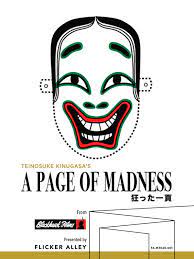
In an asylum, during a raging rainstorm, a janitor (Masao Inoue) walks along a corridor. Walking by several rooms he sees various inmates of the asylum, each in a small room with bars on the windows and doors. He stops at one cell and contemplates the woman in the cell. The woman is his wife (Yoshie Nakagawa).
The next day a young woman (Ayako Lijima) comes to the asylum to visit her mother. She finds her father is there working as the janitor. Her mother became insane due to her husband’s treatment of her. He now feels bad for the way he treated his wife and took the job as a janitor to try to find a way to help her.
At home the janitor’s daughter is getting engaged to a young man (Hiroshi Nemoto). The janitor is concerned that the madness his wife suffers from is inherited and that, if the fiancé finds out, his daughter’s wedding may be called off.
The janitor decides to sneak his wife out of the asylum. His concerns for his wife and daughter are affecting his work and he is reprimanded by the doctor (Misao Seki). The stress of his family issues and work problems causes him to have fantasies about killing the doctor. He also fantasizes that his daughter has married one of the hospital’s inmates (Kyosuke Takamatsu). His fantasies escalate to the point where he is not sure what is real and what is not.
“A Page of Madness” was released in 1926 and was directed by Teinosuke Kinugasa. It is a Japanese horror movie and an expressionistic silent film. The film had been lost for forty-five years until director Kinugasa found it in his storehouse. A lot of Japanese silent films are now lost so to have this eerie example of Japanese expressionism still survive makes it special. There is speculation that the film was longer but there’s nothing specific I could find to confirm that.
The problem with the film is that there are no intertitles. This may allow the audience to have free rein as far as interpretation is concerned but it can also add some confusion in what the viewer is seeing. Originally Japanese silent films were accompanied by narration from benshi. A benshi is a Japanese film interpreter. They would stand to the side and explain what was happening on screen by speaking for the characters. They were the sound track. They also translated when the theater was showing a foreign film. Japanese silent films also had live music accompaniment, usually in the kabuki style.
Unfortunately we have neither intertitles nor a benshi to explain what we are seeing so everything is a big guess. In addition, the fantasies and surrealism add another layer to the guessing game that represents this movie. The hallucinatory scenes are frequent and abstract so you are never really sure who is actually doing the hallucinating or exactly what these scenes actually represent. The synopsis of the film is based on the interpretation of others and falls short of what is actually on screen.
The film has been compared to German expressionism, French avant-garde and Russian montage styles. With that many styles in one film “Page” belongs to its own artistic form. It is eerie, subjective and fascinating, although confusing.

